|
WISCONSIN FIRE PUSHES 4,000 ACRESMAY 06 -- WISCONSIN RAPIDS, WI: What started Thursday afternoon as a small brush fire has reached almost 4,000 acres in central Wisconsin, forcing nearly 100 people from their homes. The Cottonville Fire was threatening about 120 buildings in Adams County, and the Green Bay News-Chronicle reported that four planes, two from Wisconsin and two from Minnesota, were dropping water all day. Jennifer Rabuck, fire information officer for the U.S. Fish & Wildlife Service, said 20 fire departments responded, with about 250 firefighters assigned. She said the fire was about 50 percent contained late last night.
One local resident said he saw the fire cross the road "in a heartbeat," spreading so fast that firefighters had trouble unloading equipment in time to catch up with the flames.
The Wisconsin Rapids Daily Tribune reported that Steve Courtney, incident commander, told dozens of residents at a local school that they planned to work the fire through the night and hope to have it contained this morning.
The state Department of Natural Resources dispatched 30 bulldozers with plows to cut line.
Jim Gobel with the DNR said a fire of this magnitude in the state is rare. "Wisconsin hasn't had a really big, huge fire like this in 25 years," he said.

SIX KILLED ON MEXICAN FIREMAY 06 -- MEXICO CITY, MEXICO: Forest fires burning in Mexico's most-populous state killed four adults and two children on Wednesday, residents who had volunteered to help fight the fires. Environment Secretary Alberto Cardenas issued an urgent call for soldiers to help with the fires outside Tejupilco. The AP reported that the fire caused evacuations and seriously injured one other person.

CHIPPEWA RxFIRE TAKES OFFMAY 06 -- GRAND RAPIDS, MN: Erratic winds turned a prescribed burn yesterday afternoon on the Chippewa National Forest into a 600-acre wildfire.
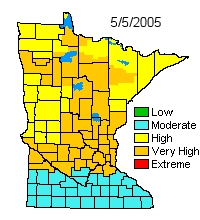 The Mississippi Meadows Fire was 10 percent contained last night at 600 acres, and a Type 2 team was ordered. The fire is is 22 miles west of Grand Rapids, burning in grass, brush, and timber. The Duluth News-Tribune reported that ten homes were evacuated, but residents were allowed to return later in the evening. Two CL-215s worked the fire, along with two helicopters, a SEAT, and 13 engines. The BIA-contracted CL-215 and one of Minnesota's CL-215s also assisted with fires in Wisconsin. The Mississippi Meadows Fire was 10 percent contained last night at 600 acres, and a Type 2 team was ordered. The fire is is 22 miles west of Grand Rapids, burning in grass, brush, and timber. The Duluth News-Tribune reported that ten homes were evacuated, but residents were allowed to return later in the evening. Two CL-215s worked the fire, along with two helicopters, a SEAT, and 13 engines. The BIA-contracted CL-215 and one of Minnesota's CL-215s also assisted with fires in Wisconsin.
The Gilman Fire northeast of St. Cloud was contained at 200 acres after burning one home and three outbuildings. Firefighters said the fire was most likely started by a re-ignited permit fire from the previous evening.
Most of Minnesota now is carrying a fire danger rating of high to very high. The statewide planning level is at 2, and ten of NDR's fire areas reported fires on Wednesday. Most areas are staffing with a full complement of personnel and equipment and are prepared for heavy initial attack. Prescribed burns are under way in many areas of the state. Minnesota's reported over 700 fires already this year, with 7,359 acres burned.

AERO UNION PILOTS REMEMBEREDMAY 05 -- CHICO, CA: Written condolences from fire agencies across the country filled a table and a wall at an Aero Union office yesterday, where friends and families gathered to honor three airtanker pilots killed last month.
Messages of sympathy from Georgia, North Carolina, Missouri, Kansas, and Florida illustrated that tanker pilots like Tom Lynch, Brian Bruns, and Paul Cockrell serve not only their communities, but the country.
The Chico Enterprise-Record reported that about 350 people showed up for a memorial service at Aero Union. Ron Hunter, company director of flight operations, said Cockrell was a quiet family man with a strong religious faith and a love of the outdoors. Bruns, he said, was known as a practical joker with a heart of gold, and Lynch was thoroughly dedicated to his job and a naturally gifted pilot.
Though he couldn't attend the memorial, State Rep. Wally Herger wrote a letter for the service read by an aide. Herger said the pilots were doing what they loved to the end. "Pilots are the luckiest people on earth," he wrote. "From now on, when I look up I will be remembering Tom, Brian and Paul."

FIREFIGHTER STATUE DEDICATED AT AIRPORTMAY 05 -- BOISE, IDAHO: A bronze firefighter statue now greets visitors at the Boise Airport; the 8½ foot statue was unveiled Monday between the terminal and the parking garage.
Vicki Minor, executive director of the Wildland Firefighter Foundation, said the statue was created from the same mold used for one of the statues at the monument site at the National Interagency Fire Center east of the airport. Vermont sculptor Larry Nowlan created three statues for the site; they were dedicated at the monument five years ago.
The Idaho Statesman reported that this is the first of many such monuments to be installed at high-profile locations -- mostly airports -- around the country. "The reason for these going in is to raise understanding and support for the role that the wildland firefighters play in protecting life and natural resources in our country," Minor said.
The Foundation is sponsoring the project, and the National Wildfire Suppression Association raised $30,000 to install the 600-pound statue. The NWSA has contributed more than $80,000 for the Foundation in the last few years.

ARIZONA FIRE BURNS 150 ACRESMAY 05 -- WICKENBURG, AZ: A cluster of fires burning northwest of Wickenburg are about a mile from several mobile homes and a ranch, and about 150 acres have burned. The Rusty Fire is about 20 miles northwest of Wickenburg, and was reported at 3 acres early yesterday afternoon. KOLD-TV reported that
60 firefighters are assigned, along with SEATs and heavy helicopters.

MANITOBA TOWNS GET FREE CL-215 SERVICEMAY 04 -- WINNIPEG, MANITOBA, CANADA: The provincial government of Manitoba has decided not to charge towns and municipalities for emergency use of waterbombers. Scott Smith, the minister responsible for emergency measures, says the move will help protect Manitobans.
"If you can imagine on a small municipality that has a budget of a couple hundred thousand dollars suddenly being hit with $70,000 or $80,000 -- it just exceeds what is reasonable," he told CBC News.
Ron Bell, president of the Association of Manitoba Municipalities, says the decision will take some of the stress out of the decision-making process during an emergency. He said fire chiefs and local officials had been second-guessing themselves about ordering the scoopers. The province has a fleet of seven CL-215s.

FORESTRY RESEARCHER WINS MAJOR AWARDMAY 03 -- SEATTLE, WA: University of Washington professor Jerry Forest Franklin was named yesterday as the recipient of the Heinz Award for the environment, an annual $250,000 prize. Franklin, professor of ecosystem analysis at the University of Washington and director of the Wind River Canopy Crane Research Facility on the Gifford Pinchot National Forest, began his forestry career as a wildland firefighter in the Columbia River Gorge. The award honors his pioneering research on old-growth forests and his advocacy for selective logging rather than clearcutting.
 Franklin received his B.S. in forest management from Oregon State University in 1959, and an M.S. in forest management and statistics in 1961, also from OSU. He earned a Ph.D. in botany and soils in 1966 from Washington State. Between 1959 and 1975 he held a variety of positions with the U.S. Forest Service, including Chief Plant Ecologist and Research Forester with the Pacific Northwest Research Station. He also directed the Ecosystem Studies Program for the National Science Foundation in Washington, DC. Franklin received his B.S. in forest management from Oregon State University in 1959, and an M.S. in forest management and statistics in 1961, also from OSU. He earned a Ph.D. in botany and soils in 1966 from Washington State. Between 1959 and 1975 he held a variety of positions with the U.S. Forest Service, including Chief Plant Ecologist and Research Forester with the Pacific Northwest Research Station. He also directed the Ecosystem Studies Program for the National Science Foundation in Washington, DC.
In 1993 he served on the Forest Ecosystem Management Assessment Team (FEMAT) headed by Jack Ward Thomas, under commission by President Clinton. Prior to that, Franklin was appointed as part of the Scientific Panel for Late Successional Forest Ecosystem (commonly known as the “Gang of Four”). He also served for 10 years on the Nature Conservancy's Board of Governors.
Former U.S. Forest Service Jack Thomas, along with the other two members of the "Gang of Four," Norm Johnson of Oregon State and John Gordon at Yale, nominated Franklin for the award.
"Jerry is a most excellent recipient of the prestigious Heinz Award," said Thomas. "He is one of those rare research types who has one foot in the camp of basic research and the other firmly planted in the day-to-day world of natural resources management. His intellect and leadership qualities are superb, and his dedication to research, teaching, and improved day-to-day forest management is a too-rare skill set. There could be no more deserving recipient.”
Franklin's got over 300 publications to his credit, and has made stellar contributions to the field of forestry. High fives, Jerry.

BACK FROM THE EDGEMAY 02 -- ORCHARD PARK, NY: Nearly 9½ years after Firefighter Don Herbert was injured in a roof collapse, he astonished doctors and his family on Saturday by asking for his wife.
 Herbert, with the Buffalo Fire Department, was left brain-damaged and mostly mute after he was injured in 1995 while fighting a house fire, and has been in a nursing home for more than seven years. Herbert, with the Buffalo Fire Department, was left brain-damaged and mostly mute after he was injured in 1995 while fighting a house fire, and has been in a nursing home for more than seven years.
When he spoke up on Saturday, nursing home staff raced to get his wife Linda on the phone. Herbert spoke with her, his four sons, and other family and friends over the weekend, according to an AP story.
"How long have I been away?" he asked.
Firefighter Anthony Liberatore told WIVB-TV that Herbert stayed up late talking with his sons. They were 14, 13, 11 and 3 when he was injured. Herbert turns 44 this Saturday.

LANDER CELEBRATION TODAYMAY 03 -- LANDER, WY: A Forest Service Centennial Celebration is planned for 10 a.m. today at the Washakie Ranger Station in Lander to recognize past and present lookouts and smokechasers. The Billings Gazette reported that one group to be honored is Wyoming's old 115th Cavalry. During World War II, the 115th Cavalry patrolled the Pacific Northwest coast to protect forests from Japanese incendiary balloon bombs. Wyoming's horse troopers worked with the smokechasers, smokejumpers, and lookouts of the region to guard against the threat. Retired USFS Deputy Chief Bob Joslin and retired FMO Bob Jacob will present awards. Historian and author Tamara Linse of the American Heritage Center and the University of Wyoming will also attend. For more information, call Karl Brauneis at the Washakie Ranger Station (307)332-5460.

ALASKA FIRE SEASON UP AND RUNNINGMAY 02 -- HOMER, ALASKA: Fire crews in Alaska have been scrambling to keep up with fires, including one from last summer that recently flared back up after smoldering all winter. Crews were needed on fires even before they'd all completed annual training and safety refreshers.
John See with the state Division of Forestry told the Associated Press that the number and size of fires is a bit early for Alaska. "Mother Nature is throwing us a curve this year," he said. "We're getting more challenging fires like what we usually would be seeing in a few weeks." More resources were requested on the 3,270-acre Tracy Avenue Fire on Kenai Peninsula, where Kurth's Type 2 team is assigned. The fire's running and torching in beetle-killed spruce, slash, grass and understory, about 9 miles northeast of Homer. The Anchorage Daily News reported that the fire tripled in size yesterday. The fire started Friday with a downed powerline; it reached 300 acres by Friday night, 1,000 acres by Saturday night, and by last night was expected to reach 4,000 acres. It was reported last night at 50 percent containment.
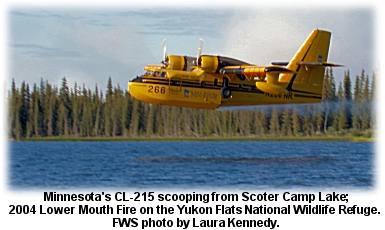 "I've been an I.C. for many years and never lost a fire like this," said state firefighter Terry Anderson. "It was a humbling experience." "I've been an I.C. for many years and never lost a fire like this," said state firefighter Terry Anderson. "It was a humbling experience."
Only one of two airtankers contracted from Canada has arrived; the other isn't due until May 10. The one on duty Sunday was initially ordered for Homer, but then was diverted to a new fire along the Alaska Railroad near Nenana. But before it got there it was diverted to a 150-acre fire northeast of Delta Junction that was threatening about 20 homes. But then another even more worrisome fire took off south of Eielson, and that's where the airtanker ended up dropping before heading back to Palmer for another load.

REDDING JUMPERS IN CENTRAL PARKMAY 01 -- NEW YORK, NY: Scaling trees in Manhattan's Central Park is not exactly where you'd expect to find a bunch of smokejumpers from Redding, California, but that's where they are. In the tallest maples, elms, chestnuts, and other trees, they're inspecting limbs for evidence of Asian long-horned beetles.
High above the ground, they're often not even noticed by park visitors. But when they are spotted, they sometimes draw a crowd.
"One police officer said, 'Now you're just part of the Central Park freak show,'" Adam Lauber told the New York Times. "You get some people upset because we're in the trees."
Lauber and four others are surveying the trees as part of the federal government's program to eradicate the Asian long-horned beetle. They were called in after the voracious beetle was discovered in trees at two Upper East Side locations. The Department of Agriculture asked the Forest Service to take the job as part of an interagency effort to search for long-horned beetles in the New York area.
Working 12-hour shifts, the jumpers have covered over 1,000 trees. "We're making a difference," said John Casey, a squadleader. "Tree climbing is the only true accurate way to know whether a tree is infested."
Dylan Reeves said some New Yorkers lean toward the paranoid. "Sometimes people think we're installing cameras in the trees," he said. Lauber probably was wishing for a camera the day he met Cameron Diaz while he was buying pizza at Whole Foods across the street.
The smokejumpers plan to return to Redding in mid-May.

ALASKA FIRE HEADED FOR SUBDIVISIONAPRIL 30 -- HOMER, ALASKA: A wildfire near Homer kept growing today while fire crews worked to keep it from a heavily populated area of town. The fire was reported Friday afternoon and had reached 800 acres this afternoon.
Kris Eriksen with the Division of Forestry in Soldotna said the fire was about two miles from the subdivision. The fire was growing mostly to the west, and the subdivision was to the southwest.
John See with the Division of Forestry said the fire has been very active, torching and spotting and spreading through dry grass and beetle-killed spruce.
Incident Commander Terry Anderson said structure protection was in place in some areas. He said someone on the Homer Spit saw a small column and called it in Friday, and he headed out East Road and reported the fire early in the afternoon as the smoke came into view. "I called in a helitack on my way here," he said, "and when I got here I called in the world."
Eriksen said the fire was active last night till about midnight, but it got moving again after 8 a.m. this morning. "That does not bode well for an easy day," she told the Anchorage Daily News. "Things are starting quite early, and they are calling in help."
Eight smokejumpers who arrived in Homer Friday from Fairbanks were still working on the fire. Volunteer fire department crews from Homer and Anchor Point, along with helicopters, were also assigned. The Division of Forestry requested 60 more firefighters, but they likely won't be available till Monday or Tuesday.
A downed powerline is the suspected cause of the fire.

OREGON SENATOR WANTS
FED REPORT ON HELICOPTER CONTRACTSAPRIL 30 -- BEND, OR: Oregon's Sen. Ron Wyden wants the federal government to examine and report on the process for contracting helicopters for the fire season, after complaints about irregularities in contracting during last year's season. At least one helicopter company says they were paid under a different type of contract than what they agreed to, according to a report by the Bend Bulletin.
Carl Gossard, assistant director for Fire & Aviation with the USFS Region 6, said he thought the government had made good on all its 2004 contracts with helicopter contractors, but he said the cancellation of contracts for 33 heavy airtankers last year did create some new problems.
Todd Peterson, marketing representative for Columbia Helicopters in Aurora, said the government started contracts with Columbia last year for exclusive-use helicopters in addition to call-when-needed contracts. He said Columbia and other helicopter companies can bid a lower daily rate under exclusive-use contracts, but he said Columbia's ships last year were paid at the lower daily rate for exclusive-use, even though they had call-when-needed agreements for a higher daily rate.
"We view this as an abuse of the exclusive-use contract," said Peterson.
At the U.S. Senate Energy Committee's subcommittee on public lands and forests hearing on fire preparedness last Tuesday, Sen. Ron Wyden asked Agriculture Undersecretary Mark Rey to submit a report outlining how the fire agencies intend to deal with the helicopter contracts. Rey agreed to produce the report, but he added that the agencies have "pretty aggressive contract people," and they had said the bids by several helicopter companies were "outrageous."
Last October, at the BLM Aviation Management Conference in Boise, Idaho, it was noted during the exclusive-use helicopter workshop that the call-when-needed contract for heavy and medium helicopters was being re-written -- with many changes. Attendees also discussed adding an “additional aircraft” clause in the exclusive-use contract to allow companies the option of adding additional helicopters at the same price for short-term use.
 Meanwhile, Aero Union's P-3s are back on duty, despite media reports indicating they'd all be "grounded," and Butler's Tanker 66 flew from Oregon to Fort Huachuca today. Meanwhile, Aero Union's P-3s are back on duty, despite media reports indicating they'd all be "grounded," and Butler's Tanker 66 flew from Oregon to Fort Huachuca today.
Butler has signed three airtankers into service for the season -- T-66 with the USFS and Tankers 60 and 62 with the Oregon Department of Forestry. Tanker 66 -- a DC-7 instrumented with stress monitoring equipment -- is on a federal contract similar to last year's P2V contracts with Minden Air and Neptune.
Butler Aircraft's Tanker 62 and Tanker 60 are scheduled to go back on duty with the Oregon Department of Forestry again this year. Unlike California, where CDF is discussing six-day coverage, ODF wants 7-day coverage on their contracts with the Butler airtankers.

PACK TEST STRESS TESTAPRIL 29 -- VENTURA, CA: A $750,000 grant awarded Tuesday by the U.S. Department of Homeland Security will help two local companies study the physiological conditions experienced by firefighters during training. Storm King Mountain Technologies of Camarillo and VivoMetrics Government Services of Ventura plan to test 500 firefighters this season.
According to the Ventura County Star, the firefighters will wear specially designed shirts under their work shirts during training to monitor exertion and stress levels. The LifeShirt® system developed by VivoMetrics is an ambulatory monitoring system that continuously collects, records, and analyzes a range of cardiopulmonary measurements. The shirt is lightweight and machine washable, with embedded sensors that collect respiratory, cardiac, blood oxygen saturation, temperature, posture and activity data that are transmitted to an incident command post.
A number of firefighters have died during annual training for the pack test, and Darrell Ralston, assistant fire chief with the Ventura County Fire Department, says this will increase safety. "We've been doing pack training for four years and we haven't had any problems with it," he said. "But we're hopeful we can be key players in deriving positive results that can help firefighters worldwide."
Jim Roth, president of Storm King Mountain Technologies, said they'll spend three months preparing for the testing, six months conducting testing, and another three months compiling and analyzing the results.

SOUTHERN CALIFORNIA FIRE CONFERENCE PLANNEDAPRIL 28 -- OAK GLEN, CA: The Southern California Association of Foresters and Fire Wardens each year sponsors a two-day training and safety conference for hundreds of firefighters from a variety of fire protection agencies. The 2005 conference will be held at Camp Pilgrim Pines at Oak Glen next week.
 An optional golf tournament on Wednesday, May 4, kicks off the event, and Thursday's agenda begins with registration at 8 a.m. The conference opens at 10 a.m., and the day's schedule will include a tour of vendor exhibits, with a barbecue dinner scheduled at 5:30 p.m. An optional golf tournament on Wednesday, May 4, kicks off the event, and Thursday's agenda begins with registration at 8 a.m. The conference opens at 10 a.m., and the day's schedule will include a tour of vendor exhibits, with a barbecue dinner scheduled at 5:30 p.m.
This year is the 75th annual conference; program topics this year include Color Coding Assessment Process for Structural Protection Risks in the Wildland/Urban Interface, History of California’s Large Wildland Fires, Infrared Mapping System, and staff rides to the Rattlesnake, Inaja, and Loop Fires. There will be updates on this year's outlook for fuels, weather, and aircraft, and a presentation on CDF's Helitack 404 burnover.
John Maclean, author of Fire on the Mountain and Fire and Ashes, will also attend.
There is a fee of $80 for the two-day conference, which includes the Association's 2005 membership fee, along with all training and safety presentations, a vendor display, vendor’s sales counters, evening entertainment, equipment displays, and all meals served at Camp Pilgrim Pines. Overnight lodging is available at the camp, or just across the road at Camp Luther Glen for an additional fee. More details are available online from the SCAFFW website or by calling Pilgrim Pines at (800)616-6612 or Doug Lannon at (909)881-6920.

WYOMING CONCERNED ABOUT FUNDING CUTSAPRIL 28 -- LANDER, WY: Facing a potentially dangerous wildfire season and major cuts in federal assistance to at-risk communities, officials in Wyoming are worried that the Bush administration's proposed 2006 budget could pinch the state with a $500,000 cut in federal cooperative forestry funds. State Forester Bill Crapser, according to the Jackson Hole Star-Tribune, says it's too early to say what that cut would mean, but that federal fire prevention funds for local fire departments would be ended
Wyoming's combined state and national forest plan budgets were just shy of $2 million for fiscal year 2004, he said; the 2006 budget is estimated at $1.6 million.
Tom Troxel, Rocky Mountain director for the Intermountain Forestry Association, said he supports a greater emphasis in the federal budget on timber sales and fuels reduction projects near communities; he said timber sales and fire prevention projects are not mutually exclusive.

WESTERN GOVERNORS WANT
I.A. PERMISSION FROM FEDSAPRIL 28 -- SPOKANE, WA: Northwest governors plan to ask federal agencies for permission to initial attack wildfires on federal lands this summer.
"We're going to ask the federal government to allow us to respond immediately, so we do not have issues of jurisdiction," said Montana Gov. Brian Schweitzer. "We want first-strike capability. It might be a state response on federal land."
Also attending the meeting in Spokane yesterday were Washington Gov. Christine Gregoire, Oregon Gov. Ted Kulongoski, and Idaho Gov. Dirk Kempthorne. According to an AP story in the Seattle Times, Gregoire said Washington has already had 55 wildfires this season.
The governors also discussed sharing National Guard troops and aircraft. Schweitzer said half of Montana's National Guard members -- and many of their aircraft -- are in Iraq.
The governors agreed they want answers soon from the federal government on issues of airworthiness of heavy airtankers. Kempthorne said they would send a joint letter asking the government to resolve the safety questions.

FOREST SERVICE WANTS MORE P-3sAPRIL 27 -- WASHINGTON, DC: Agriculture Undersecretary Mark Rey said Tuesday that the Forest Service plans to put more P-3 Orions on contract, but that the plan may be re-evaluated in light of the crash of Aero Union's Tanker 26 last week. He told the U.S. Senate Energy Committee's subcommittee on public lands and forests during Tuesday's hearing on fire preparedness that there was no indication the plane had suffered structural failure in flight.
"As we look at where to go going forward," said Rey, "we were leaning and may still yet lean toward acquiring additional P-3s, because the military has a number of Orion P-3s that can be resurrected at a reasonable cost and used as the backbone of a larger tanker fleet in conjunction with all the other aviation assets."
According to an AP story, Rey said the government's longer-term plan is to assemble a firefighting fleet dependent more on helicopters and less on large fixed-wing airtankers. He was questioned by Western lawmakers who have focused on the airtanker issue since last May. Sen. Jeff Bingaman of New Mexico said he was unclear on the plan. "I had sort of thought we were on the way to getting that fixed," he said, "but I guess my information was erroneous."
Rey said the 2005 aviation plan includes six heavy airtankers, six large helitankers and helicopters, and more than 70 light and medium helicopters. State and interagency agreements will also make available two exclusive-use CL-215 scoopers, 28 exclusive-use SEATs, and approximately 70 call-when-needed SEATs. They expect that two or three call-when-needed CL-215s will also be available, along with eight MAFFS units.
"The heavy airtankers will continue to be downloaded by 15 percent by weight of retardant as an extra precaution," he said. "All of the airtankers have been configured with traffic collision avoidance systems. In addition, three heavy airtankers will be returned to limited service to collect operational loads data to be used in determining the mechanical stresses of aerial firefighting." He said operational loads monitoring equipment will be installed in all activated airtankers for additional safety and data gathering.
Rey was pressed by Sen. Ron Wyden of Oregon to move more quickly on negotiating contracts with companies in Oregon that want to provide helicopters.

T-26 INVESTIGATION DONE,
P-3s BACK ONAPRIL 26 -- CHICO, CA: Investigators at the site of last week's airtanker crash north of Chico have completed their examination of the wreckage, but haven't yest come to any conclusions. The crash, which killed three veteran pilots employed by Aero Union and destroyed one of its P-3 Orions, has been under scrutiny by the National Transportation Safety Board and others since Thursday.
NTSB investigator Paul Schlamm said their documentation will be reviewed and submitted as part of a final investigation, which also includes examination of maintenance records and interviewing other pilots who had recently flown Tanker 26, according to the Chico Enterprise-Record.
Aero Union has established a memorial fund for the families of the pilots. Donations can be made by sending checks to "Trust of Tanker 26 Families," 100 Lockheed Avenue, Chico, California 95973.
Media speculation that the tragedy might keep Aero Union's remaining P-3s on the ground was dispelled on Friday. After a one-day stand-down out of respect, Aero Union pilots were asked whether they wanted to fly, and they unanimously voted to get back in the air as soon as possible. The Forest Service agreed, and cleared the tankers for immediate return to service.

SHERIFF'S DEPUTY CHARGED IN FLORIDA FIREAPRIL 26 -- VIERA, FL: A Brevard County sheriff's deputy, Henry Schook, has been charged with setting a wildfire. Free on $5,000 bond, the 27-year-old Schook was placed on paid emergency suspension from his job with the county.
WTEV-TV reported that state arson investigators watched Schook set a fire while on patrol early Monday; they've been monitoring him as a suspect since February, when the Division of Forestry reported a number of suspicious fires in Brevard County.
The Sun-Sentinel reported that Schook used a flare from the trunk of his cruiser to set the fire. Investigators suspect it was at least the tenth time since January that he had set a fire while on duty. He was arrested on charges of intentional or reckless burning of land and illegal possession of an incendiary device.
"It's disappointing that it's a law enforcement officer; that's for sure," said Lt. Col. Lou Leinhauser. Evidence including flares and residue may link Schook to more than ten other fires and several vehicle fires.

P-3s BACK ON?APRIL 22 -- BOISE, IDAHO: The four Aero Union P-3 airtankers currently on contract were temporarily stood down yesterday after Wednesday's crash of Tanker 26 that killed three pilots, but an internal Forest Service memo this afternoon said an announcement was expected today that the other contracted P-3s would be back on duty tomorrow.
The memo said that USFS "Aviation and Contracting will be releasing a statement this afternoon regarding the status of the 4 P-3s currently on contract." Aviation personnel said they expected the Aero Union tankers to be available for fire response starting tomorrow.
A team of investigators arrived yesterday and completed an initial review of the crash site. The investigation began in earnest today, and was expected to focus on the tanker's power plant, airworthiness, and maintenance records.
In an AP story, KVOA-TV in Tucson reported that the NTSB's initial review found all the wreckage within a two-acre burn zone, according to the NTSB's Paul Schlamm. And Matt Mathes with USFS Region 5 public affairs said there didn't appear to be any structural causes for the crash.
"This is certainly a promising development," said Mathes. "We're going to wait for more information as the investigation proceeds, but we are cautiously optimistic." He said Aero Union's tankers were rigorously inspected last year. "We put that particular plane through two kinds of tests," he said. "It has passed every single test we can give it."
More than a dozen investigators worked today at the incident site, and they reviewed pilot logs and maintenance records at Chico. Schlamm said that Tanker 26 had left the airport late Wednesday with 2,500 gallons of water onboard, but it was not yet clear whether the crew had dropped the water before the crash.
Firefighting pilots and airtanker contracting operators have complained for years about a perceived lack of communication between them and the federal firefighting agencies. The National Interagency Fire Center's site at www.nifc.gov, for example, hasn't had a new post since Monday, and their front-page link for "Large Airtanker Contract Status" hasn't been updated since August 2004. Forest Service Fire & Aviation Management, where the announcement noted in today's widely-distributed memo was expected, last updated their online "News Room" on April 5. The USFS Aviation office also had nothing online late today.
As NTSB investigators search for the cause of Wednesday's fatal crash, politicians are scrutinizing the risks of the reduced federal airtanker fleet, resulting from last year's abrupt cancellation of federal tanker contracts. Members of Congress, including Sen. Dianne Feinstein of California, are pressuring the federal Departments of Agriculture and the Interior about plans for upgrading the fleet. The Pasadena Star-News reported that California's senior U.S. senator said she contacted both departments seeking solutions. "We urgently need to have tankers," said her staff member Howard Gantman.
California State Rep. Wally Herger lobbied hard last year to get Aero Union's tankers back in the air. Yesterday he called Mark Rey, the USDA undersecretary who oversees the Forest Service, about Aero Union's fleet.
Larry Brosnan, USFS assistant director of aviation, said the fatal accident won't immediately affect the agency's contract with Aero Union. The Chico Enterprise-Record reported that Brosnan and other USFS officials expressed confidence in Aero Union's aircraft after they passed rigorous inspections last year.
"We've inspected their aircraft twice and we're confident of their airworthiness," Brosnan said.
Tanker 26 had been scheduled for federal inspection today and was to begin flying May 1 for a six-month contract.

BIG ARIZONA FIREAPRIL 22 -- TUCSON, AZ: A wildfire near Picacho Peak had grown to about 1,200 acres last night; the Foster Fire started in the afternoon north of Picacho Peak. An AP story said about 90 firefighters were assigned.
Cliff Pearlberg with the state Land Department said seven engines and two SEATs were on the fire.
The 150-acre Antonio Fire in the Patagonia Mountains on the Coronado, near the Mexican border, was contained last night.
The East Valley Tribune reported that Bush administration plans to slash $30 million from U.S. Forest Service programs -- for example, State & Private Forestry, which funds fuels reduction projects for states and local communities -- will delay or scrap critical projects. State Forester Kirk Rowdabaugh said forested land in the state is already dangerously overgrown, and any delay in thinning heightens the risk of another devastating fire like the 2002 Rodeo-Chediski complex.
"The need is immediate," Rowdabaugh said. "We can’t do enough fast enough to avoid the danger of a Rodeo-Chediski. The threat is real. The need to move as quickly as we can is real."
Hank Kashdan, budget director for the Forest Service, said complaints that the budget shortchanges thinning are not valid. He said the planned budget does reduce grants to local communities, but it increases spending on hazardous fuels reductions within the forests by $19 million.
The fire danger across Arizona remains high, particularly in the deserts where rains have produced heavy vegetation that will dry out this summer. Rowdabaugh said that rains were heavier than normal this year, but long-term projections indicate a return to prolonged drought.

TANKER 26 GOES DOWN, P-3s STOOD DOWN APRIL 21 -- CHICO, CA: APRIL 21 -- CHICO, CA:
Aero Union's Tanker 26, one of its P-3 Orions, crashed last evening north of Chico while on a training mission with three pilots aboard.
A rescue team spent several hours overnight making their way into the rugged area of the Ishi Wilderness, and this morning there was no word on any survivors. The FAA later confirmed three fatalities.
"Our thoughts and prayers go with the families of Tom Lynch, Brian Bruns and Paul Cockrell," said Aero Union's president Terry Unsworth. "The loss affects each and every one of us deeply. Our immediate concern is for the families and providing the support they need."
A small fire that started after the crash was estimated this morning by the rescue team at about three acres. They said the aircraft debris was scattered over approximately 5 - 8 acres, and a fire crew had lined it this morning. The Tehama County Search and Rescue crew were released about 11 a.m.
The fatal flight -- a training mission -- was the seventh of the day for Tanker 26, which was due for its Forest Service inspection tomorrow.
Chuck Wamack, the assistant center manager at the National Interagency Coordination Center in Boise, said that Forest Service aviation managers requested a temporary stand-down of all contracted P-3 tankers. The duration of the stand-down has not been determined.
Rose Davis with public affairs at NIFC, however, indicated today it would probably be just a day or two. She said the NTSB has sent a team from Washington, DC -- including NTSB Vice Chairman Mark Rosenker -- for the accident investigation, but that the Forest Service would not be a part of the investigation because the tanker was not on a firefighting mission. She said the Forest Service is "aggressively" working with Avenger Aircraft Services on an Operational Service Life Determination for the P2V-5 and P2V-7 airtankers.
She also cautioned agency employees against speculation, and suggested that condolences
to Aero Union employees and others in the airtanker industry were in order.


FIRE SAFETY SUMMIT SCHEDULED FOR MISSOULAAPRIL 20 -- MISSOULA, MT: Firefighter safety issues and concerns are on the agenda in Missoula next week, with the annual Wildland Fire Safety Summit slated for April 26 - 28 at the University of Montana. It's sponsored by the International Association of Wildland Fire, and the Missoulian reported that conference organizers expect more than 400 firefighters and fire managers from around the world.
Retired U.S. Forest Service researcher Bob Mutch will be the keynote speaker, with his analysis of the 2003 Cedar Fire in southern California. Incident commander liability has become a hot issue since the Thirtymile Fire and the Cramer Fire, and U.S. Attorney Mike Johns of Phoenix will discuss "Liability Issues Related to Wildland Fire Personnel.''
The banquet speaker is John Maclean, author of Fire on the Mountain and Fire and Ashes. He will discuss "The New Age of Fire: Storm King and Beyond.'' Breakout groups will identify issues and develop recommendations at the local, regional, national, and international scale; results will be presented to wildland firefighting agencies.
Online registration is available through the University of Montana.
The International Association of Widland Fire (IAWF) is a non-profit organization representing the wildland fire community. Arrangements have been made for reduced airfares; from most large airports in the West, fares are under $300.
This year's safety summit is the "10th Anniversary Conference" in recognition of the 1995 Human Factors Workshop, a landmark event in firefighter safety. Major sponsors are MTDC, the University of Montana's National Center for Landscape Fire Analysis, and the NWCG's Safety & Health Working Team. For more information, call the conference vendor coordinator, Howard Dupuis, at (705)945-5774 or Bill Gabbert at (605)890-2348 or Dick Mangan at (406)543-0013.

WELSH FIREFIGHTERS STONED BY TEENSAPRIL 20 -- CARDIFF, SOUTH WALES, UK: Fire crews are facing attacks in many small south Wales communities, according to new research for the Fire Brigades Union. Their study identified a series of attacks in villages over the last couple years, and the BBC News reported that fires were started deliberately to lure crews in.
 Firefighters were then pelted with stones and bricks by teenage gangs. Firefighters were then pelted with stones and bricks by teenage gangs.
The Fire Brigades Union wants a new law to make assaulting an emergency worker a distinct offence. Regional Secretary Dick Pearson said central coordination is needed to address the problem.
"It's frightening," he said. "Even when you are attacked by kids of seven, eight or nine, if you have a group of them around you trying to rob things off you or throwing stones, it's a pretty ugly environment." He said firefighters get distracted by people trying to steal things from fire engines, and that firefighters can't deliver the service that they're capable of when they're under attack.
The North Wales Daily Post reported that brigade bosses are warning that firefighters could be killed by thugs luring them into ambushes. North Wales Fire and Rescue Service is backing up the union study showing 40 attacks a week on firefighters throughout the UK.
North Wales assistant chief fire officer Colin Hanks said there have been 23 assaults on his crews in the last two years, including incidents where bricks, bottles, and missiles were thrown at firefighters. "My concerns are that eventually this anti-social behavior will result in serious injury or death to a firefighter, or a member of the public if firefighters are prevented from doing their jobs during these attacks," said Hanks. "At some incidents, crews have to contend with various items being thrown at them, or having their equipment damaged, such as smashed fire engine windscreens."
The Guardian reported that scaffolding poles have been thrown through engine windscreens, and in one incident a child was killed by youths with air guns while crews fought a fire. Andy Gilchrist, union secretary, said the number and ferocity of attacks appear to be getting worse. "A young boy died in Scotland during one attack," he said, "and it is only a question of time before a firefighter is killed." He said it shouldn't be part of anyone's job to get a brick or bottle in the head.
Union Regional Secretary Pearson, based in Port Talbot, said attacks on fire crews are a growing problem across the UK. Although there were around 2,000 recorded attacks per year, he said there's a serious problem of under-reporting such incidents. He said legislation in Scotland makes it distinct criminal offence to attack an emergency service worker, but that the Welsh assembly does not have law-making powers in Wales.

MILITARY EXERCISE STARTED MASSACHUSETTS FIREAPRIL 19 -- DEVENS, MA: A large brushfire burning on the South Post of Devens yesterday grew to 300 acres; the Worcester Telegram reported that it started Saturday on the firing range in the reserve forces training area east of Leominster.
The former Fort Devens in north-central Massachusetts was over 9,000 acres across North Post, Main Post, and South Post. The current Devens Reserve Forces Training Area (RFTA) covers about 5,200 acres -- primarily on South Post.
The Range Fire was reportedly 10 percent contained last night at 500 acres.
The Eastern Area Coordination Center reported that all air resources responded to fires yesterday, including the interagency exclusive-use CL-215, three USFS Beavers, Minnesota's Cessna 206, and the two state CL-215 scoopers. EACC reported red flag warnings for parts of the Northeast yesterday, with fire weather watches posted across much of New England.
Michigan's Boyce Lake Fire southwest of Roscommon was contained at 1,556 acres after it threatened about 20 homes; several homes were saved by firebreaks. Michigan DNR called it the state's worst fire in five years.

FIRE IN SOUTH DAKOTAAPRIL 18 -- STURGIS, SD: A fire near Dome Mountain northwest of Galena started yesterday afternoon and rapidly grew to over 100 acres; it was reported this morning at 325 acres. KOTA-TV reported that the Camp 5 Fire is at the head of Vanocker Canyon, and firefighters reported crowning and running with spot fires 200 yards ahead of the main fire.
KELO-TV reported that the fire's five miles from Deadwood just south of Sturgis. Officials last night closed Boulder Canyon Highway 14-A.
Part of the fire is in an area burned by the Grizzly Gulch Fire in 2002. Two SEATs are working the fire, some of which is burning in rugged and inaccessible terrain. Grassland Fire Danger is rated from high to extreme over most of South Dakota for today.

WYOMING FIRE EVACUATES TOWNAPRIL 17 -- FORT WASHAKIE, WY: KUTV News reported that the town of Fort Washakie on the Wind River Reservation was evacuated yesterday.
One building was burned -- the former Bureau of Indian Affairs headquarters for the reservation. The building has been vacant for several years.
An AP story in NEWSDAY said all the roads into Fort Washakie were cut off.
Ivan Posey, chairman of the Eastern Shoshone Tribe, said the fire was burning in thick vegetation in the Little Wind River bed and winds were gusting to 35 mph.
The reservation, about 160 miles west of Casper, is home to about 8,000 members of the Eastern Shoshone and Northern Arapahoe tribes.

BUDGET CUTS SQUEEZE USFSAPRIL 17 -- WASHINGTON, DC: The Forest Service plans to close some recreation sites and sell unused ranger stations as part of a budget squeeze driven by record deficits, the decline of the timber industry, and the new "healthy forests" law aimed at reducing the risk of catastrophic wildfires. An AP story in the Seattle Post-Intelligencer noted a proposed $56 million increase for projects to reduce wildfire risks, but the overall Forest Service budget would be cut by 5.8 percent, to $4.07 billion, in the fiscal year beginning this fall.
The numbers illustrate the hard choices facing the USFS in its centennial year.
"This budget is a tight budget, and our priority is healthy forests and reducing the risk of catastrophic fire, so trade-offs have to be made," said Hank Kashdan, the agency's budget chief.
Western politicians, however, say the cutbacks could severely limit suppression capabilities, and many expect this to be one of the worst wildfire seasons in memory.
"Communities out here are bracing for a tough wildfire season," said John Hummel, city councilman in Bend, Oregon. "We need all the help we can get." He said this is no time for the administration to cut fire-related funding, and he's worried about cuts in state and local wildfire assistance.
Kashdan said the agency will have enough money to maintain a 99 percent success rate in initial attack -- a goal that was met during last year's minimal fire season.
In five of the last six years, the USFS has exceeded its suppression budget and borrowed from other programs, including those that target prevention, such as fuels reduction and local assistance. Sen. Bob Bennett of Utah said he and other Western lawmakers are furious over Bush's proposal to cut $283 million in fire management programs.
Rep. Peter DeFazio of Oregon said the Bush administration has never come close to requesting the full $760 million per year authorized under the 2003 Healthy Forests Restoration Act, and Congress has never come close to fully funding it. He estimated the tab for adequately reducing fuel loads at $1 billion per year -- more than double the $462 million appropriated for fuels reduction last year.

DELAWARE FIREFIGHTERS SCRAMBLEAPRIL 16 -- MILLSBORO, DE: Sussex County crews on Friday fought a forest fire that drew 100 firefighters from nine companies to contain it. On Wednesday about 300 firefighters from 21 companies worked on a larger version of the same fire west of Millsboro.
Hot spots in the duff got a boost on Friday from strong winds, but crews contained the fire to five or six acres, according to the News-Journal. Wednesday's fire burned almost 170 acres. "That's big for Delaware," said State Forester Austin Short.
Across the region, isolated showers with mostly dry and warm weather are forecast. The Eastern Area Coordination Center reports that very low fine fuel moisture and RH will increase fire danger in the Northeast. EACC has sent outstanding resource orders out of the region already, and Minnesota has gone to Preparedness Level 3. Aircraft resources include three CL-215 water scoopers, a Cessna 206, and three Beavers. Tanker 267, a CL-215 under interagency contract, flew back from Arizona yesterday.
In Wisconsin, fire danger's reported at extreme; no precipitation has occurred since April 5. Dispatch centers report maximum staffing and aerial detection flights under way.

DNR TIGHTENS RESTRICTIONS IN MICHIGANAPRIL 15 -- DETROIT, MI: Spring is the most dangerous time for wildfires in Michigan, and the last two weeks were so dry that the state Department of Natural Resources has banned campfires and open burning on nearly all the land it manages. Campfires within fire rings at designated campgrounds in state parks are still allowed, but the Detroit Free Press reported that no open fires of any kind are allowed in state forest campsites outside the parks.
"Right now, the fire danger in most places is very high or extreme," said Paul Kollmeyer, fire control specialist at the Cadillac DNR office. "I suspect that by this weekend it will be at extreme just about everywhere in the state."
Crews have responded already to over 150 wildfires, well ahead of normal spring numbers. Kollmeyer said nearly every volunteer fire department in northern Michigan has been busy since early April. A Houghton Lake Resorter story said there were 72 wildfires in the Lower Peninsula last week; out-of-control brush or leaf fires have been the most common cause, but the largest fire this week, which burned 250 acres in Montmorency County, was caused by a spark when a disc pulled by a tractor hit a rock.
Kollmeyer said this year is the 15th anniversary of a spring 1990 fire that destroyed dozens of homes and structures along the banks of the Au Sable River; it was the most destructive forest fire in dollar amounts in state history.

MARYSVILLE FIREFIGHTER KILLED IN PLANE CRASHAPRIL 12 -- OAK HARBOR, WA: Paramedic Theodore Mathews, 48, died after his 1941 single-engine Stinson went down Friday afternoon in a marshy area south of Oak Harbor. His wife Karen was killed in the crash. Mathews was severely burned in the crash; he was airlifted to Harborview Medical Center in Seattle, where he died Saturday morning.
The Mathewses are survived by a daughter.
Nathan Trauernicht with the Marysville Fire District said firefighters gathered Mathews's uniform and boots outside Station 61 and left flowers as a memorial. He said Mathews was an avid pilot. "He loved -- he absolutely loved -- flying," said Trauernicht. "That was a frequent conversation at the fire station."
The cause of the crash is under investigation by the National Transportation Safety Board; Debra Eckrote, a senior air safety investigator with the NTSB, told the Everett Daily Herald that a preliminary cause could be released as early as today, but the final determination likely will take up to three months.
Or longer. NTSB reports are still pending for four aerial firefighting crashes that occurred over the last few years. Tanker 99 went down near San Bernardino in October 2003, killing two pilots. Tankers 92 and 87 crashed near Hopland, California, in August 2001. Two pilots were killed. Two SEATs went down last year, one near Safford, Arizona, and another near St. George, Utah; both pilots died.
None of the NTSB reports for those incidents have been released.
The Southwest Regional Office of the NTSB is at 1515 West 190th Street #555, Gardena, California 90248. The phone number is (310)380-5660.

SOUTH KOREAN FIRE EVACUATES HUNDREDSAPRIL 11 -- SEOUL, SOUTH KOREA: Nearly 3,000 people evacuated their homes in South Korea last week while thousands of firefighters and soldiers worked to contain brushfires that spread to residential areas. The Times of Oman reported that the fires started last Monday in a forest near Yangyang, 125 miles east of Seoul, and were pushed by strong winds to nearby villages. The 1,100-acre fire burned Naksansa, a 1,300-year-old Buddhist temple; the head monk said the temple lost one of its three national treasures.
Prime Minister Lee Hae-Chan called an emergency government meeting to discuss measures to stop the spread of the fires. About 6,000 emergency personnel, including firefighters and soldiers, worked the fires, with 180 engines and 15 helicopters. They were contained by Wednesday.
The JoongAng Daily reported that more than 40 homes were burned.
An editorial in the JoongAng Daily noted the need for a nationwide disaster management system. It said the Forestry Service has 41 helicopters but only two of them can fly in winds over 33 mph -- so 39 of them were grounded when the winds were blowing at 56 mph early in the day.

FIRE RISK ALONG THE TRAILAPRIL 11 -- POMPEYS PILLAR NATIONAL MONUMENT, MONTANA: About 50,000 people each year visit the jutting sandstone butte near Billings that was engraved by explorer William Clark. The Pillar overlooks the Yellowstone River; it's about 150 feet high and it's the only sandstone outcrop on the south side of the Yellowstone River for several miles in either direction. It's been a landmark for centuries, and visitors are warned by signs and guides of the fire danger in this part of Montana.
With thousands more visitors expected this year because of bicentenial events along the Lewis & Clark Trail, federal land managers are looking for creative new ways to reach travelers.
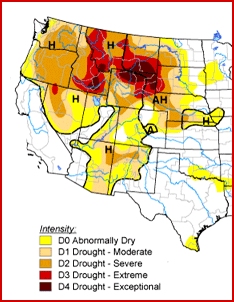 A report in the Billings Gazette noted that prevention plans are in the works for sites along the way, including the Missouri River Breaks and Lolo Pass. The BLM will haul an interpretive trailer with fold-out exhibits to bicentennial events across the region. A report in the Billings Gazette noted that prevention plans are in the works for sites along the way, including the Missouri River Breaks and Lolo Pass. The BLM will haul an interpretive trailer with fold-out exhibits to bicentennial events across the region.
"Are we worried? You bet," said Mike Dannenberg, a fire education and mitigation specialist with the BLM in Billings. He said increased numbers of visitors on lands that are parched after years of drought just fuels the potential for accidental fires.
Winter snowpack was at or near record lows in several Pacific Northwest states, and the federal Climate Prediction Center says drought conditions will persist in western Montana, all of Idaho, and parts of Oregon and Washington.
Fire officials are developing prevention plans for the more popular areas along the trail, including Pompeys Pillar, the Breaks, Fort Benton, Three Forks, and Lolo Pass.
Monument manager Dick Kodeski said Pompeys Pillar, a developed and controlled BLM recreation site, will be open to visitors regardless of the fire season.

FIREFIGHTERS INJURED ON NORTH DAKOTA GRASS FIREAPRIL 09 -- BISMARCK, ND: Three firefighters working on a grass fire north of Bismarck were burned and have been hospitalized, according to a report by KXMC News. Bismarck Rural Fire Chief Keith Sailer said one of the firefighters had a broken leg and burns, and the other two were burned. The fire started southwest of Wilton and was being pushed by high winds. Much of the area was under a red flag warning yesterday.
Dry fuels and strong winds pushed several other fires in northeastern South Dakota yesterday; the largest, southeast of Mellette, was about three miles long and a half-mile wide, according to the Aberdeen American News. The fire burned through stacked hay bales on a farm after embers flared up in a pile of trees burned earlier this year. Two smaller grass fires were contained in Spink County yesterday, one near Doland and another near Ashton.
Minnesota was busy yesterday, too -- aircraft resources already on include a CL-215 scooper, a Cessna 206, and three DHC-2 Beavers. Red flag warnings were posted in central, western, and southern Minnesota, and dispatch reported that all the aircraft flew multiple fires. Crews were busy with initial attack all day. Aero Union's Tanker 27 flew up to Brainerd from Fort Smith yesterday; it was dispatched to a new fire north of Minneapolis as soon as it entered the state.
The 200-acre Section 18 Fire north of Morrill was at zero containment last night, and firefighters reported that fire behavior was "erratic and extreme." The fire's threatened two homes.

NO CRIMINAL CHARGES IN FIREFIGHTER'S DEATHAPRIL 09 -- SAN JOSE, CA: The Santa Clara County district attorney will not file criminal charges against homeowners whose house fire contributed to the electrocution death of a county fire captain. The San Francisco Chronicle reported that Capt. Mark McCormack was killed by a downed powerline at the house fire in Los Gatos.
Investigators from the county fire department, the sheriff's department, and the federal Bureau of Alcohol, Tobacco and Firearms all asked the district attorney to file charges of involuntary manslaughter against the homeowners, but the district attorney said McCormack's death was indirectly caused by the residents' inattention to burning incense in the home -- not sufficient for criminal charges.

KENTUCKY ARSONIST ARRESTEDAPRIL 08 -- McKEE, KY: Police arrested a Jackson County man and charged him with felony arson in connection with a 65-acre forest fire in eastern Kentucky. Christopher K. Stewart of Tyner could be sentenced to one to five years in prison if convicted. kentucky.com reported that Stewart will appear in court on April 25.
The fire was one of several that have burned recently in the area. State crews worked several hours to contain it. Nearly 300 fires in the state already this year have been attributed to arson.

AIRTANKERS START THE SEASONAPRIL 07 -- CHICO, CA: As the 2005 fire season begins in some parts of the country, some ships of the aerial firefighting fleet are returning to service. Four of Aero Union's P-3 Orions were approved by the U.S. Forest Service the last week of March, and three of them headed for the Southeast. The fourth, Tanker 20, officially starts on April 15 but is currently available at Chico if needed.
 Tanker 27 has been at Fort Smith, Arkansas; Tanker 26 was at Chico today. Tanker 07 -- one of Neptune's P2Vs -- is parked at Missoula, and their Tanker 44 is at Alamogordo. Tanker 27 has been at Fort Smith, Arkansas; Tanker 26 was at Chico today. Tanker 07 -- one of Neptune's P2Vs -- is parked at Missoula, and their Tanker 44 is at Alamogordo.
An AP story in the Casper Star-Tribune noted that 20 heavy airtankers are expected back on contract this year; seven of the 20 have already been cleared to go. Rose Davis at NIFC said 27 SEATs will be on exclusive contracts with the Forest Service and Department of the Interior, and they'll have 50 on a call-when-needed basis.
Meanwhile, the Chico Enterprise-Record reported that Seattle-based Lake Union Capital Partners is buying Aero Union in Chico. Terry Unsworth, company president, will stay on, along with Aero Union's 183 employees.
The Chico News & Review reported that former owners Vic Alistur and the two Newton brothers will no longer be involved with the business.

In other California news, CDF's tankers will be back on a 7-day schedule after pilots and others objected to the agency's plans to cut the S-2s to six days. The Ukiah Daily Journal reported that pilots will be trained for staffing seven days a week, avoiding possible cuts that would have kept tankers on the ground one day every week.
"They said we are going to restaff back to seven days per week but are not submitting anything in writing until April 1," said pilot Doug Baker. "They said to restaff and are going to train everybody as if we are going to do staffing seven days a week. It sounds like we are back in business."
DynCorp, the company who employs S-2 pilots in California, had contacted pilots about CDF discussions on parking airtankers for one day each week and laying off relief pilots for the upcoming season to save money. Baker said that would have reduced the tanker fleet by 15 percent, not to mention losing a number of the younger pilots through reduced staffing.
In Montana, Neptune Aviation has apparently been told by the Forest Service that most of their planes remain "ineligible" for service this year. The Missoulian reported that Neptune did bid on the contracts for this year, the first seven of which were awarded to Aero Union. Rose Davis at NIFC said Neptune still had "a lack of data" on the service life of their P2V tankers. The Forest Service still maintains that it needs more information on the planes before the agency can resume work with Neptune. The USFS contracted with first one and then another company to research the life and structure of the aircraft; last August one of Neptune's tankers was fitted with a system to monitor aircraft structure and stress as a test program. Davis said Tuesday that last year's data was insufficient.
The USFS has now contracted with a third engineering company -- for $300,000 -- to complete another inspection of the P2Vs by early June.

SCOOPERS TRAINING IN CANADAAPRIL 06 -- KENORA, ONTARIO, CANADA: Super Scoopers have been landing regularly on open water at Lake of the Woods in the last few days; the Kenora Daily Miner reported today that CL-415 pilots with the Ministry of Natural Resources’ Aviation and Forest Fire Management Branch have been getting in some early spring training this year. They're using Lake of the Woods and the Winnipeg River because of the availability of open water.
“Kenora is a real good fit for us because of the current there," said chief pilot and trainer Carl Hansson; "it opens it up real quick." Hansson's been doing the training for a dozen years and says this is the earliest in the spring that it's occurred.
The Thunder Bay Chronicle-Journal reported last week that the Northwest Fire Management Centre is gearing up for the annual return of firefighters, including the region’s 114 four-person crews. About 80 fire crew leaders will arrive for a refresher session April 12 in Dryden. All fire crews should be in place by the second week of May.
The West Fire Region, which stretches from Marathon to the Manitoba border, will have the same numbers of CL-415s and support aircraft as last year, including the seven CL-415s and two Twin Otters.
The current scooper training program is for the three dozen pilots who fly the seven CL-415s in the western fire region. Hansson said 26 are assigned to the CL-415s full-time; he and the other pilots are cross-trained in case they're needed.
Hansson said flight training includes several scoops and drops, but that near the end of the training an engine loss is simulated after a scoop. The pilot must immediately dump the water because with an engine loss, the plane wouldn't have the power to climb with a full load. Hansson said they can ditch 13,500 pounds in half a second, but they're careful about where they drop it.
“If you hit the wrong button and drop all that water on somebody’s cottage," he said, "we wouldn’t be welcome in the Kenora area any more.”

TANKERS VACATING HEMET?APRIL 06 -- HEMET, CA: The Riverside County Board of Supervisors will consider next week a resolution opposing the planned move next year of the state's firefighting aircraft from the Hemet-Ryan tanker base to March Air Reserve Base. Supervisor Jeff Stone of Temecula claims the move would compromise public safety and private property because March is farther away from fire-prone areas; he said moving the four aircraft stationed at Hemet would leave areas around Idyllwild and the southwest county vulnerable.
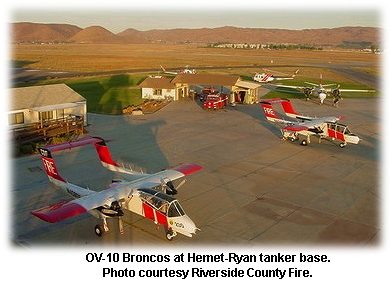 "This is an issue of paramount importance to the area," Stone told The Californian. "The bottom line is, it's going to create at least a ten- to fifteen-minute delay in getting these airtankers to the places where wildland fires are most likely to occur." "This is an issue of paramount importance to the area," Stone told The Californian. "The bottom line is, it's going to create at least a ten- to fifteen-minute delay in getting these airtankers to the places where wildland fires are most likely to occur."
But Supervisor Bob Buster said he won't support Stone's proposed resolution. He said March is a better location because bad-weather landings and takeoffs are easier there, and March has a longer runway. He also disputes Stone's concern about delays in response times.
"From a time standpoint, there's not a dime's worth of difference," he said.
Former county Supervisor Jim Venable (who learned to fly at age 14 and took over his father's Hemet Valley Flying Service in 1960) suggested in 1997 that the move to March was a good idea because of recreational ultra-light and sail plane traffic at Hemet-Ryan.
State funding for the move has been approved, and construction of buildings and hangars could start this summer.
The base at March has a long history -- Congress in early 1917 appropriated some $640 million to build "an army in the air." Frank Miller, then owner of the Mission Inn in Riverside, Hiram Johnson, and others gained War Department approval to construct an airfield at Alessandro Field near Riverside. In early 1918 the building foundations were excavated, and on March 20, 1918, Alessandro Flying Training Field became March Field, named in honor of Second Lieutenant Peyton C. March, Jr., son of the Army Chief of Staff, who had been killed in a flying accident in Texas the previous month.
From 1949 to 1953, the B-29 Superfortresses dominated the flightline at March Air Force Base. After the Korean Conflict the wing converted from B-29s to B-47 jet bombers and their supporting tankers, the KC-97s.
In 1993 March Air Force Base was selected for "realignment," and the 445th Airlift Wing was transferred to March from Norton AFB. In 1994 the 22d Air Refueling Wing was transferred to McConnell AFB in Kansas; March's two Reserve units were deactivated and their personnel and equipment joined under the 452d Air Mobility Wing. On April 1, 1996, March officially became March Air Reserve Base.
 Hemet-Ryan's history is also long and colorful. Ryan Air Attack Base was named after the late Claude T. Ryan, who designed the Spirit of St. Louis and started the Ryan School of Aeronautics in Hemet during World War II. The facility eventually became a public airport owned and operated by Riverside County. Hemet-Ryan's history is also long and colorful. Ryan Air Attack Base was named after the late Claude T. Ryan, who designed the Spirit of St. Louis and started the Ryan School of Aeronautics in Hemet during World War II. The facility eventually became a public airport owned and operated by Riverside County.
In 1957 the U.S. Forest Service began airtanker loading operations and in 1959 CDF started operations. Both agencies maintained separate parking, loading, and mixing areas at first; the operations were merged in 1969 and the two agencies began sharing responsibilities and facilities. The joint base concept continued till 1998 when the USFS moved its operations to Norton Air Force Base.
Ryan is one of 19 tanker bases in California and provides initial attack on more than 17,000 square miles of private, state, and federal lands. Up until 1998 Ryan was the busiest tanker base in the country. Activity dropped off dramatically when the USFS moved to San Bernardino.

FLORIDA FIRE SEASON UNDER WAYAPRIL 06 -- MIAMI, FL: Sunny days, sea breeze, and dry air in Florida have got fire and weather officials expecting a busy fire season. Brevard County Fire Rescue officials say they expect more fires than usual in the next few months, and they're urging residents to work on defensible space around their homes.
"We just want people to be alert," Orlando Dominguez told Florida Today. "This is when we start having that transitional weather pattern. The rain we've been getting will stop and the humidity will drop." He said they expect lightning storms in the next month.
Firefighters on Sunday contained a small fire in Cocoa, the third fire in the area in two weeks.
The county's had 9½ inches of rain this year, over an inch above normal. Scott Kelly, a meteorologist with the National Weather Service in Melbourne, said the area's driest months are March, April, and May. "We're right in the peak of the fire season," he said, "but we've also had quite a bit of rainfall, so it's not quite as severe."
The worst season on record for Brevard was in 1998 when fires burned thousands of acres and destroyed 32 homes. For two years before that, central Florida had abundant rainfall that fueled the growth of brush. Fires took off when temperatures climbed into the 100s and rain became sparse.
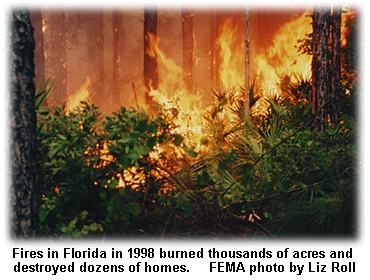 And last year's hurricanes have added to the potential for big fires. And last year's hurricanes have added to the potential for big fires.
"With four major hurricanes last year, we had significant vegetative fuel buildup as all those hurricanes came through and blew debris down," Jim Karels with the Florida Division of Forestry told TV20 News. He said the potential for catastrophic wildfires is high over the next couple of years.
Fire crews have been working on prescribed fires to reduce fuels. Crews at Eglin Air Force Base burned 3,200 acres in the last couple days; 22 prescribed fires treating over 12,000 acres were conducted across the Southern Region yesterday. The Southern Area Coordination Center reported 342 wildfires for just over 3,700 acres yesterday in Kentucky, North Carolina, Oklahoma, Tennessee, and Virginia. The Hopper Flat Fire in Oklahoma was contained at 180 acres.
On Sunday afternoon police closed Card Sound Road, which links Florida City and the Florida Keys, when a grass fire ignited near a rock quarry. The toll road is the only alternate route to the Keys from U.S. Highway 1 and the Florida Division of Forestry advised police to keep the road closed all night. But Lt. Eric Baum with Miami-Dade Fire Rescue said the road was opened intermittently while firefighters contained the fire. Baum told the Miami Herald that Fire Rescue workers were hauling water from a nearby canal to fight the 100-acre fire.

WYOMING EXPECTING BUSY SEASONAPRIL 05 -- CASPER, WY: Wyoming State Forester Bill Crapser says the state this season will plan for the worst and hope for the best, and fire officials are keeping an eye on the northeast part of the state. Snowpack levels there are just 54 percent of average in the Belle Fourche River drainage. But that could change.
"Last year with the drought, we were predicting it was going to be a barnstorm of a fire season," he said, "and it rained all summer."
He told the Casper Star-Tribune that the state's working with local firefighters on additional training for the season, and inmates in Riverton and Newcastle are being trained for fire response.
The Forestry Division manages 270,000 acres of forested state trust lands in Wyoming, and has fire protection responsibilities for 3.6 million acres of state land.
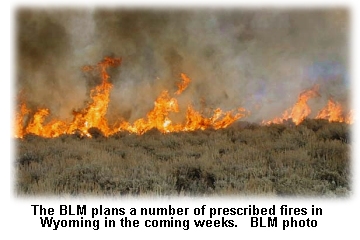 The BLM plans to start spring prescribed burning on the Firehole Basin Project south of Rock Springs tomorrow and will continue the burn through Friday. Thor Stephenson, fuels management specialist at Rock Springs, said three days should be all they need to complete the project. The burn is west of highway 191, south of the Firehole highway, north of the lower Sage Creek Road, and east of Sweetwater County road 75. The BLM plans to start spring prescribed burning on the Firehole Basin Project south of Rock Springs tomorrow and will continue the burn through Friday. Thor Stephenson, fuels management specialist at Rock Springs, said three days should be all they need to complete the project. The burn is west of highway 191, south of the Firehole highway, north of the lower Sage Creek Road, and east of Sweetwater County road 75.
The BLM Rawlins office plans five prescribed burns this spring to improve wildlife habitat, livestock distribution, and riparian and rangeland health:
- Beaver Hills is a 1,000-acre project 10 miles east of Encampment
- West Barrett Ridge, at 1,700 acres, is 13 miles northeast of Encampment
- Homestead, an 800-acre project, is 15 miles east of Baggs near Battle Mountain
- Little Sandstone is a 500-acre burn planned four miles northeast of Savery
- Riddle Creek, at 1,500 acres, is 20 miles northeast of Rawlins
For more information, contact Mary Wilson at (307)328-4329 or Thor Stephenson at (307)352-0369.

WISCONSIN, MINNESOTA, AND
MICHIGAN FIRE DANGER HIGHAPRIL 04 -- EAU CLAIRE, WI: The Eau Claire area is under a high fire danger warning until more rain falls, according to a report by WQOW News, and the state DNR is warning people to be careful.
Eau Claire Battalion Chief Kerry Parker said residents need burning permits from their local fire department before burning yard debris.
Township firefighters say the ground may look wet from melting snow, but last year's grass is still present -- and very dry. Fire danger is high or very high through the middle of the state.
Many fires are accidentally started by homeowners burning brush on their property; a 79-year-old woman near Lonedell, Missouri, died this week when her clothes caught fire while she was raking and burning brush in her yard.
Michigan firefighters have been busy with grass fires, too. A fire recently took off near Jackson when high winds picked up a brush fire.
"Every fire department in the county is probably out fighting grass fires right now," Liberty Township Chief Tom Carpenter told the Jackson Citizen-Patriot. The area is ripe for grass fires, according to Spring Arbor Fire Chief Tim McEldowney, who said most grass fires are started when homeowners abandon a leaf burn or brush pile. "They leave the fire just for one minute as they go inside the house," he said, "and when they come back, it's gotten away from them."
Capt. John Hardesty with the Leoni Township Fire Department said they responded to 10 grass fires last week.
The Manistee side of the Huron-Manistee National Forest has been working fires for the past five days, according to the Eastern Area Coordination Center. They reported 11 fires yesterday, and noted Forest staff assisted the Michigan DNR with a 50-acre fire. The 200-acre Hound Fire northeast of Staples burned one outbuilding before it was contained.
The Michigan DNR fire info site indicates burning restrictions through much of the middle of the state.
| 









 Franklin received his B.S. in forest management from Oregon State University in 1959, and an M.S. in forest management and statistics in 1961, also from OSU. He earned a Ph.D. in botany and soils in 1966 from Washington State. Between 1959 and 1975 he held a variety of positions with the U.S. Forest Service, including Chief Plant Ecologist and Research Forester with the Pacific Northwest Research Station. He also directed the Ecosystem Studies Program for the National Science Foundation in Washington, DC.
Franklin received his B.S. in forest management from Oregon State University in 1959, and an M.S. in forest management and statistics in 1961, also from OSU. He earned a Ph.D. in botany and soils in 1966 from Washington State. Between 1959 and 1975 he held a variety of positions with the U.S. Forest Service, including Chief Plant Ecologist and Research Forester with the Pacific Northwest Research Station. He also directed the Ecosystem Studies Program for the National Science Foundation in Washington, DC.
 Herbert, with the
Herbert, with the  "I've been an I.C. for many years and never lost a fire like this," said state firefighter Terry Anderson. "It was a humbling experience."
"I've been an I.C. for many years and never lost a fire like this," said state firefighter Terry Anderson. "It was a humbling experience."

 An optional golf tournament on Wednesday, May 4, kicks off the event, and Thursday's agenda begins with registration at 8 a.m. The conference opens at 10 a.m., and the day's schedule will include a tour of vendor exhibits, with a barbecue dinner scheduled at 5:30 p.m.
An optional golf tournament on Wednesday, May 4, kicks off the event, and Thursday's agenda begins with registration at 8 a.m. The conference opens at 10 a.m., and the day's schedule will include a tour of vendor exhibits, with a barbecue dinner scheduled at 5:30 p.m.
 APRIL 21 -- CHICO, CA:
APRIL 21 -- CHICO, CA:

 A report in the
A report in the  Tanker 27 has been at Fort Smith, Arkansas; Tanker 26 was at Chico today. Tanker 07 -- one of Neptune's P2Vs -- is parked at Missoula, and their Tanker 44 is at Alamogordo.
Tanker 27 has been at Fort Smith, Arkansas; Tanker 26 was at Chico today. Tanker 07 -- one of Neptune's P2Vs -- is parked at Missoula, and their Tanker 44 is at Alamogordo.

 "This is an issue of paramount importance to the area," Stone told
"This is an issue of paramount importance to the area," Stone told  Hemet-Ryan's history is also long and colorful. Ryan Air Attack Base was named after the late Claude T. Ryan, who designed the Spirit of St. Louis and started the Ryan School of Aeronautics in Hemet during World War II. The facility eventually became a public airport owned and operated by Riverside County.
Hemet-Ryan's history is also long and colorful. Ryan Air Attack Base was named after the late Claude T. Ryan, who designed the Spirit of St. Louis and started the Ryan School of Aeronautics in Hemet during World War II. The facility eventually became a public airport owned and operated by Riverside County.
 And last year's hurricanes have added to the potential for big fires.
And last year's hurricanes have added to the potential for big fires.
 The BLM plans to start spring prescribed burning on the Firehole Basin Project south of Rock Springs tomorrow and will continue the burn through Friday. Thor Stephenson, fuels management specialist at Rock Springs, said three days should be all they need to complete the project. The burn is west of highway 191, south of the Firehole highway, north of the lower Sage Creek Road, and east of Sweetwater County road 75.
The BLM plans to start spring prescribed burning on the Firehole Basin Project south of Rock Springs tomorrow and will continue the burn through Friday. Thor Stephenson, fuels management specialist at Rock Springs, said three days should be all they need to complete the project. The burn is west of highway 191, south of the Firehole highway, north of the lower Sage Creek Road, and east of Sweetwater County road 75.